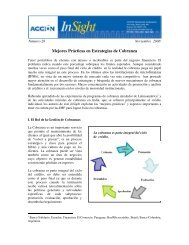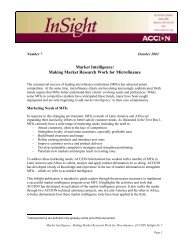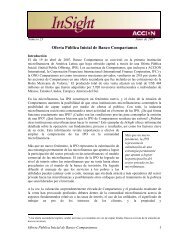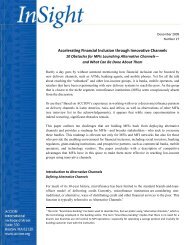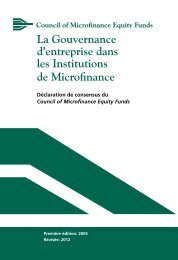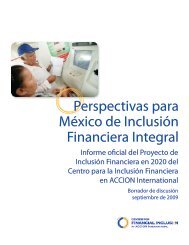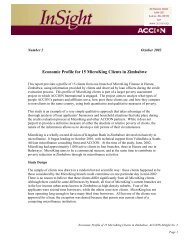the Universal Standards for Social Performance Management
the Universal Standards for Social Performance Management
the Universal Standards for Social Performance Management
Create successful ePaper yourself
Turn your PDF publications into a flip-book with our unique Google optimized e-Paper software.
terms of compliance. This indicates that, in many regards, additional and concerted ef<strong>for</strong>t is needed on <strong>the</strong> part ofMFIs.However, <strong>the</strong> Essential Practices are seen as applicable and achievable given some time, and MFIs reported that<strong>the</strong>y were able to measure <strong>the</strong>ir status by looking at <strong>the</strong> mission, strategic goals, and policies and procedures of<strong>the</strong> organization.Specific Practices of Note (easiest, most difficult, inapplicable, confusing, etc.)MFIs found <strong>the</strong> Essential Practices related to setting strategy and mission easiest to achieve (especially 1a1 to 1a3,“The institution has a social mission. . . ,” “The institution has target clients. . . ,” and “The institution has socialgoals. . .”), while more difficult were those that required setting specific indicators and targets, and using data tomonitor <strong>the</strong>se goals. In particular, 1a4 (“The institution has social indicators. . .”) and 1a5 (“The institution hassocial targets <strong>for</strong> outputs and outcomes. . .”) stood out as challenging, which had a ripple impact on <strong>the</strong> EssentialPractices in 1b (involving collecting and reporting on such data). This may suggest necessary sequencing <strong>for</strong>education or phasing-in <strong>the</strong> EPs. A few MFIs also reported confusion about <strong>the</strong> language in 1a3 to 1a5, suggestinga need <strong>for</strong> clarification about outputs and outcomes. Collecting data on outcomes is also more difficult than doingso <strong>for</strong> outputs, so <strong>the</strong>se EPs could potentially be broken into two to recognize this challenge.MFIs found <strong>the</strong> most challenging EP to be 1b5, “If <strong>the</strong> institution states poverty reduction as one of its social goals,it monitors <strong>the</strong> poverty levels of its clients using a poverty assessment tool.” While MFIs find this EP important,<strong>the</strong>y also believe it requires significant time and resources. This could be an area in which MFIs need additionalsupport and guidance.2. Ensure Board, <strong>Management</strong>, and Employee Commitment to <strong>Social</strong> GoalsOverall Comments on this SectionWith an average overall completion rate of 74.3% and a standard deviation of 25%, this section ranked fifth of sixin terms of compliance.Multiple organizations struggled with knowing how to assess <strong>the</strong>mselves against some of EPs: many participantssaid <strong>the</strong>y “don’t know” if <strong>the</strong>ir organization had achieved <strong>the</strong> EPs in this section. In general <strong>the</strong>re was a lack ofknowledge from staff about what goes on at <strong>the</strong> Board level, suggesting 1) a need <strong>for</strong> improved internalcommunications, 2) <strong>the</strong> need to target questions in this section to knowledgeable individuals, and 3) that someEPs need to be clarified (are currently too vague). We hope that <strong>the</strong> addition of indicators will assist with clarity.Although organizations struggled to respond to this section, <strong>the</strong> EPs were seen as applicable and achievable.Specific Practices of Note (easiest, most difficult, inapplicable, confusing, etc.)As noted, many MFIs reported “don’t know” responses <strong>for</strong> a variety of reasons. One EP that stood out asespecially vague was 2b4 ("The Board prevents institutional mission drift during changes in ownership structureand/or legal <strong>for</strong>m”).Some of <strong>the</strong> issues outlined in Section 1 trickle down to Section 2. MFIs reported that <strong>the</strong>y struggled with specificsocial indicators in Section 1; <strong>the</strong>re<strong>for</strong>e <strong>the</strong>re are issues with <strong>the</strong> EPs in Section 2 that deal with <strong>the</strong> Boardanalyzing such data. Additionally, MFIs that were confused about indicators/outcomes/outputs in Section 1 againexperienced challenges with EPs like 2c2 (“Senior management analyzes social per<strong>for</strong>mance data, including dataon client-level outcomes, to compare <strong>the</strong> institution’s actual per<strong>for</strong>mance against its stated social targets”).17



